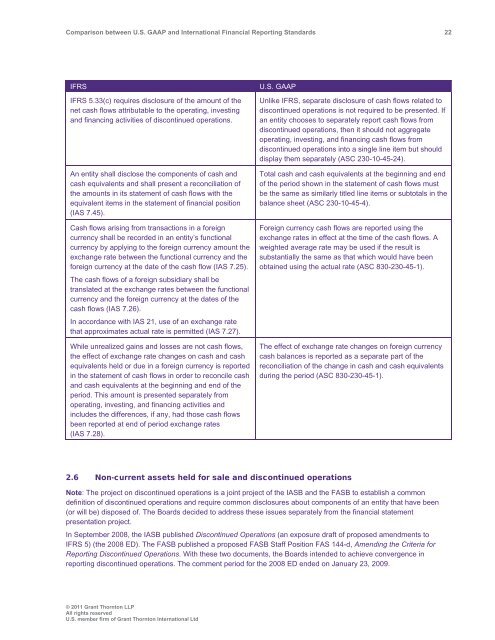Comparison between U.S. GAAP and International ... - Grant Thornton
Comparison between U.S. GAAP and International ... - Grant Thornton
Comparison between U.S. GAAP and International ... - Grant Thornton
Create successful ePaper yourself
Turn your PDF publications into a flip-book with our unique Google optimized e-Paper software.
<strong>Comparison</strong> <strong>between</strong> U.S. <strong>GAAP</strong> <strong>and</strong> <strong>International</strong> Financial Reporting St<strong>and</strong>ards 22<br />
IFRS<br />
IFRS 5.33(c) requires disclosure of the amount of the<br />
net cash flows attributable to the operating, investing<br />
<strong>and</strong> financing activities of discontinued operations.<br />
An entity shall disclose the components of cash <strong>and</strong><br />
cash equivalents <strong>and</strong> shall present a reconciliation of<br />
the amounts in its statement of cash flows with the<br />
equivalent items in the statement of financial position<br />
(IAS 7.45).<br />
Cash flows arising from transactions in a foreign<br />
currency shall be recorded in an entity’s functional<br />
currency by applying to the foreign currency amount the<br />
exchange rate <strong>between</strong> the functional currency <strong>and</strong> the<br />
foreign currency at the date of the cash flow (IAS 7.25).<br />
The cash flows of a foreign subsidiary shall be<br />
translated at the exchange rates <strong>between</strong> the functional<br />
currency <strong>and</strong> the foreign currency at the dates of the<br />
cash flows (IAS 7.26).<br />
In accordance with IAS 21, use of an exchange rate<br />
that approximates actual rate is permitted (IAS 7.27).<br />
While unrealized gains <strong>and</strong> losses are not cash flows,<br />
the effect of exchange rate changes on cash <strong>and</strong> cash<br />
equivalents held or due in a foreign currency is reported<br />
in the statement of cash flows in order to reconcile cash<br />
<strong>and</strong> cash equivalents at the beginning <strong>and</strong> end of the<br />
period. This amount is presented separately from<br />
operating, investing, <strong>and</strong> financing activities <strong>and</strong><br />
includes the differences, if any, had those cash flows<br />
been reported at end of period exchange rates<br />
(IAS 7.28).<br />
U.S. <strong>GAAP</strong><br />
Unlike IFRS, separate disclosure of cash flows related to<br />
discontinued operations is not required to be presented. If<br />
an entity chooses to separately report cash flows from<br />
discontinued operations, then it should not aggregate<br />
operating, investing, <strong>and</strong> financing cash flows from<br />
discontinued operations into a single line item but should<br />
display them separately (ASC 230-10-45-24).<br />
Total cash <strong>and</strong> cash equivalents at the beginning <strong>and</strong> end<br />
of the period shown in the statement of cash flows must<br />
be the same as similarly titled line items or subtotals in the<br />
balance sheet (ASC 230-10-45-4).<br />
Foreign currency cash flows are reported using the<br />
exchange rates in effect at the time of the cash flows. A<br />
weighted average rate may be used if the result is<br />
substantially the same as that which would have been<br />
obtained using the actual rate (ASC 830-230-45-1).<br />
The effect of exchange rate changes on foreign currency<br />
cash balances is reported as a separate part of the<br />
reconciliation of the change in cash <strong>and</strong> cash equivalents<br />
during the period (ASC 830-230-45-1).<br />
2.6 Non-current assets held for sale <strong>and</strong> discontinued operations<br />
Note: The project on discontinued operations is a joint project of the IASB <strong>and</strong> the FASB to establish a common<br />
definition of discontinued operations <strong>and</strong> require common disclosures about components of an entity that have been<br />
(or will be) disposed of. The Boards decided to address these issues separately from the financial statement<br />
presentation project.<br />
In September 2008, the IASB published Discontinued Operations (an exposure draft of proposed amendments to<br />
IFRS 5) (the 2008 ED). The FASB published a proposed FASB Staff Position FAS 144-d, Amending the Criteria for<br />
Reporting Discontinued Operations. With these two documents, the Boards intended to achieve convergence in<br />
reporting discontinued operations. The comment period for the 2008 ED ended on January 23, 2009.<br />
© 2011 <strong>Grant</strong> <strong>Thornton</strong> LLP<br />
All rights reserved<br />
U.S. member firm of <strong>Grant</strong> <strong>Thornton</strong> <strong>International</strong> Ltd
















